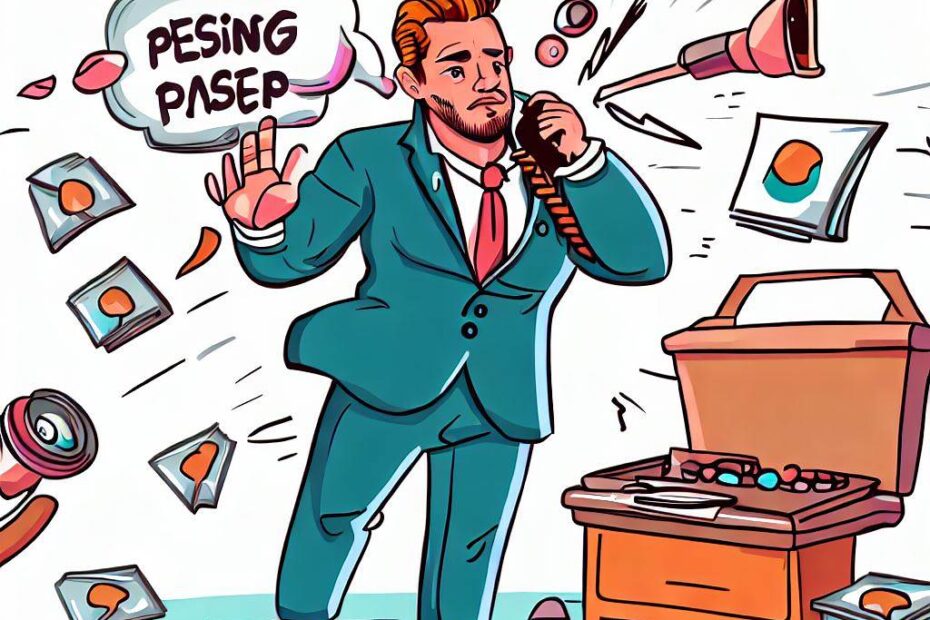To achieve successful lead generation and deal closure, it is crucial to understand the keys to prospecting success and avoid common mistakes. Sales prospecting, an essential element of any effective sales strategy, entails identifying and reaching out to potential customers who demonstrate interest in your product or service. However, salespeople often make critical mistakes that hinder their ability to generate high-quality leads and close deals effectively. In this article, we will discuss two common prospecting mistakes made by salespeople and how to avoid them.
Prospecting Mistake 1: Salespeople Don’t Have a Solid Strategy for Developing Enough Good Prospects

One of the most significant challenges salespeople face when it comes to closing deals is having too many unqualified prospects in their pipeline. These are individuals who may not be the right fit for the product or service, lack the decision-making power, or cannot afford the offering. Such prospects can clog up the pipeline and delay the entire sales process.
To avoid such a scenario, salespeople need to develop a solid strategy for generating high-quality prospects. They must identify the characteristics of their ideal customer, including demographics, pain points, and buying behaviors. This information can help focus their efforts on prospects who are more likely to convert into paying customers.
Salespeople should also tailor their messaging to address the unique needs and interests of each prospect. This requires researching the prospect’s company, industry, and competition to gain a better understanding of what motivates them. By doing this, salespeople can create a personalized pitch that resonates with the prospect and increases their chances of converting.
Moreover, they must track their progress regularly and measure the effectiveness of their prospecting efforts. This can involve evaluating metrics like conversion rates, time spent on a call, and the number of follow-up calls required to close a deal. Analyzing these metrics can help identify areas for improvement and refine the prospecting strategy further.
Prospecting Mistake 2: Salespeople Don’t Spend Enough Time Prospecting and They Don’t Maximize Their Time

Another common prospecting mistake is not allocating enough time to prospecting or failing to use that time efficiently. Salespeople often get caught up in day-to-day tasks, such as responding to emails or attending meetings, which can distract them from their prospecting goals.
To avoid this trap, salespeople must make prospecting a priority and set aside dedicated time for it. This involves putting prospecting time on their calendar and treating it like any other appointment. By doing so, they are more likely to follow through and avoid pushing prospecting activities to a later date continually.
Setting specific targets and goals for prospecting can also help maximize the time spent on it. This involves determining how much time is needed to invest each day, week, or month in prospecting and blocking off the time on their calendar. They should also consider using an accountability partner to stay on track and remain motivated.
In addition, salespeople can explore different prospecting methods that work best for them, such as social selling, cold calling, email campaigns, or attending networking events. Experimenting with various approaches can help identify the most effective ones and maximize the time spent on prospecting.
Effective prospecting is critical to the success of any sales strategy. Salespeople must develop a solid prospecting strategy that focuses on generating high-quality leads and tailor their messaging to address the unique needs and interests of each prospect. Additionally, they must allocate dedicated time for prospecting, set specific goals, and use metrics to measure the effectiveness of their efforts continually. By avoiding common prospecting mistakes and optimizing their prospecting approach, salespeople can increase their chances of closing deals and driving revenue growth.
Prospecting Mistake 3: Salespeople Stop Once They Experience a Little Success

Prospecting is a crucial aspect of any salesperson’s job, especially for those in the B2B sector. However, it is common for salespeople to make mistakes that hinder their success in prospecting. One such mistake is when salespeople stop prospecting once they experience a little success.
This mistake can occur due to various reasons. Perhaps the salesperson has landed a few big clients, and they feel that they have enough business to sustain them for a while. Maybe they are too busy servicing existing clients and do not have the time or energy to devote to finding new prospects. Or, the salesperson may simply be overconfident, thinking that they have developed a foolproof prospecting strategy that does not require much effort.
Whatever the reason may be, stopping prospecting once you experience a little success is a surefire way to create a feast-or-famine cycle in your sales pipeline. Sure, you may have enough business to sustain you for a while, but eventually, those clients will move on, or their needs will change, leaving you without any backup plan. Therefore, it is important to keep prospecting even during busy times and to avoid making this mistake.
One way to ensure that you keep prospecting even during busy times is to make a minimum number of prospecting calls each week. Even if you have tons of proposals flowing and lots of client work to do, making a couple of outreach calls a week will keep your prospecting muscles toned up. It is like working out after a three or four-week layoff. You may feel rusty at first, but once you get back into the habit, it becomes easier and more natural.
Moreover, making a minimum number of prospecting calls each week will also keep a fresh trickle of new business prospects flowing into your pipeline on a regular basis. The key here is consistency. Even if you only make a few calls each week, doing it consistently over time will yield better results than sporadic bursts of prospecting activity.
During busy times, another way to keep your prospecting efforts going is to develop a list of clients or prospects whom you intend to make contact with over a period of time. This can be for a week or a month, depending on how busy you are. Keep this list with you wherever you go, whether it is in a physical notebook or on your smartphone. Keeping the names and numbers in front of you will make it easier to pick up the phone between meetings or over lunch breaks.
Furthermore, having a list of clients or prospects whom you intend to contact will also act as a great physical reminder of what you need to accomplish. Having a tangible list that you can cross off as you go along provides a sense of accomplishment and helps you stay focused on your goals. The key here, again, is consistency. Don’t stop until you’ve checked all the names off the list.
When you’re feeling good about yourself and confident, it is the perfect time to ask for more referrals and work your network. Referrals are an excellent source of new business opportunities, and they can help keep a constant amount of new business floating to the surface. Moreover, working your network and building relationships with people in your industry can also lead to new business opportunities down the line.
Salespeople should avoid making the mistake of stopping prospecting once they experience a little success. It is essential to keep prospecting even during busy times and to make a minimum number of prospecting calls each week. Developing a list of clients or prospects to contact and asking for more referrals during busy times can also help keep a constant flow of new business opportunities. Remember, consistency is key. By avoiding this mistake, salespeople can create a sustainable sales pipeline that ensures long-term success.
The Prospecting Script Template: A guide to effective communication with clients

In the world of sales, prospecting is an essential step in the process of acquiring new clients and expanding business relationships. However, prospecting can be a challenging task, especially when you are interacting with potential clients for the first time. To make this process easier and more effective, having a clear and concise script template can be incredibly helpful. In this article, we will discuss a highly effective prospecting script template that can help you make a strong impression on potential clients.
1. Introduction
The first step in this script template is introducing yourself over the phone. Begin by stating your name and the company you represent. This initial introduction should be polite, professional, and brief. You should also aim to build rapport with the person on the other end of the line by using a friendly and warm tone of voice.
2. Reason for the Call
After introducing yourself, it is essential to provide a clear reason for the call. The purpose of this call is to schedule a meeting with the client to explore their needs. In this section, you should explain that you have recently taken over a specific area and that you have reviewed some information about the client’s organization. It is essential to highlight that your research indicates that your organization has not conducted a Needs Analysis with them. Highlighting this helps to create a sense of urgency and importance around the conversation.
3. Needs Analysis Explanation
It is important to explain precisely what a “Needs Analysis” entails. This step aims to clarify any misconceptions the client may have and establish the value of the meeting. Be direct and clear about the kinds of questions that you would ask, and discuss the key benefits of conducting a Needs Analysis. Explaining how this type of analysis can improve the client’s business and bring value to their organization can be a compelling motivator.
4. Removing Pain or Providing Pleasure
This section of the script template is all about articulating the company’s value proposition. The goal is to provide concrete examples of how your organization can add value to their business and improve it, either by providing a solution to an existing pain point or by delivering some desired pleasure. You could mention that your company helps cut down on costs (X), stop losing revenue (Y), increase revenue (Z), or even bring more customers through the door (XX). Here, you want to communicate that you not only understand what their business needs are but also have a solution to address them.
5. Are You Open?
After highlighting the benefits of conducting a Needs Analysis and explaining the value proposition, it’s time to ask the client if they are open to new ideas in these areas. This question serves as a litmus test to see if the client is interested in exploring the idea further. This simple question can give you a lot of insight into whether this prospect might be worth pursuing further.
6. Scheduling a Meeting
Finally, it’s time to schedule a meeting to explore the potential for collaboration. Use language that creates a sense of urgency and excitement about the meeting. For instance, you could say, “Great! Then we need to meet. How does this Tuesday work for you?” Be sure to suggest specific dates and times so that scheduling is smooth and seamless.
This prospecting script template can help establish a foundation for effective communication with clients. By following this template, you can approach each interaction with confidence and clarity, making a stronger impression and increasing the likelihood of turning prospects into clients. Remember to always personalize the script, keep the tone friendly and professional, and actively listen to your potential client’s responses. With practice, this template will become second nature, and you’ll soon see the positive results that come from effective prospecting.
Conclusion
In conclusion, effective sales prospecting is crucial for the success of any sales strategy. Salespeople need to avoid common prospecting mistakes such as not having a solid strategy for developing enough good prospects, not spending enough time prospecting, and stopping once they experience a little success. By developing a solid prospecting strategy that focuses on generating high-quality leads and using a prospecting script template, salespeople can increase their chances of closing deals and driving revenue growth. Consistency is key, and salespeople must track their progress regularly, measure the effectiveness of their prospecting efforts, and refine their strategies continuously. With these tips in mind, salespeople can create a sustainable sales pipeline that ensures long-term success.
